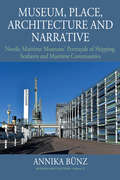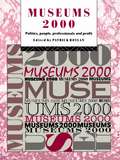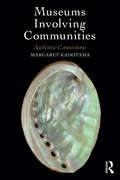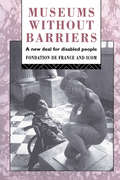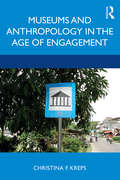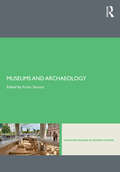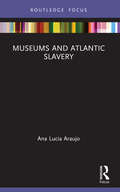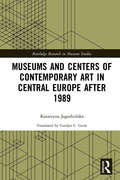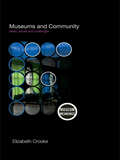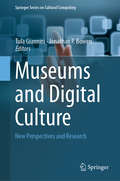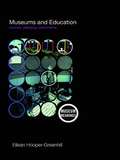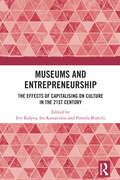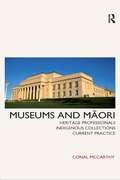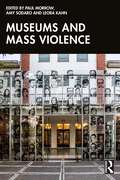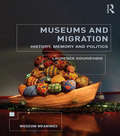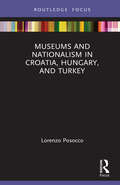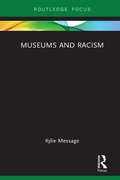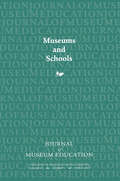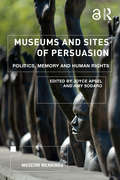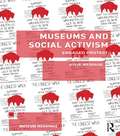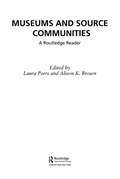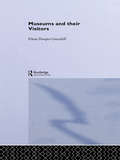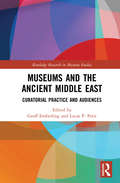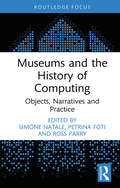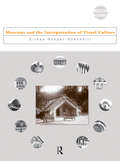- Table View
- List View
Museum, Place, Architecture and Narrative: Nordic Maritime Museums’ Portrayals of Shipping, Seafarers and Maritime Communities (Museums and Collections #15)
by Annika BünzA characteristic trait of the maritime museums is that they are often located in a contemporary and/or historical environment from which the collections and narratives originate. The museum can thereby be directly linked to the site and its history. It is therefore vital to investigate the maritime museums in terms of relationships between landscape, architecture, museum and collections. This volume unravels the kinds of worlds and realities the Nordic maritime museums stage, which identities and national myths they depict, and how they make use of both the surrounding maritime environments and the architectural properties of the museum buildings.
Museums 2000: Politics, People, Professionals and Profit (Heritage: Care-Preservation-Management)
by Patrick J. BoylanMuseum and art galleries have never been so much in the news as they have been over the past decade. Yet public focus at both professional and non-specialist levels has been remarkable for what has been accidentally or deliberatley left out of recent debates. Moving beyond the narrow issues of professional practice, Museums 2000 probes the political, economic and cultural realities which affect museums today. Because the contributos are drawn from the museum profession and the wider political, academic and business community worldwide, the book is truly international, reflecting the issues which affect all museums.
Museums Involving Communities: Authentic Connections
by Margaret KadoyamaMuseums Involving Communities: Authentic Connections explores how museums can become more active and also considers how they might involve members of their local communities in their everyday work. Examining the key components of the museum–community relationship, this book looks at both the impact of museums on the cultural and civic lives of local communities and the impact of local communities on the programs, collections, and organizational culture of museums. Advocating an accessible and inclusive approach to museum management, Kadoyama focuses on the role of museum leadership in fostering and deepening community relationships. The result offers insights into how relationships between communities and museums can be forged in practice, how museums can be involved in building healthier communities, and how community engagement strategies can be developed, implemented, and evaluated successfully. Written by an experienced museum professional with extensive experience in community involvement and audience development, Museums Involving Communities is key reading for museum workers looking to make an impact, while building long-term relations with local communities, to the benefit of both museum and community. It should also be of great interest to students taking courses in museum and heritage studies.
Museums Without Barriers: A New Deal For the Disabled (Heritage: Care-Preservation-Management)
by Fondation de France/ICOMEssential reading for all professionals concerned with museums and the cultural heritage, with the architecture and design of museums and for those providing service for the disabled. The volume provides access to some of the best practice in the provision for the disabled, and sets out an agenda for future action in museums worldwide.
Museums and Anthropology in the Age of Engagement
by Christina KrepsMuseums and Anthropology in the Age of Engagement considers changes that have been taking place in museum anthropology as it has been responding to pressures to be more socially relevant, useful, and accountable to diverse communities. Based on the author’s own research and applied work over the past 30 years, the book gives examples of the wide-ranging work being carried out today in museum anthropology as both an academic, scholarly field and variety of applied, public anthropology. While it examines major trends that characterize our current "age of engagement," the book also critically examines the public role of museums and anthropology in colonial and postcolonial contexts, namely in the US, the Netherlands, and Indonesia. Throughout the book, Kreps questions what purposes and interests museums and anthropology serve in these different times and places. Museums and Anthropology in the Age of Engagement is a valuable resource for readers interested in an historical and comparative study of museums and anthropology, and the forms engagement has taken. It should be especially useful to students and instructors looking for a text that provides in one volume a history of museum anthropology and methods for doing critical, reflexive museum ethnography and collaborative work.
Museums and Archaeology (Leicester Readers in Museum Studies)
by Robin SkeatesMuseums and Archaeology brings together a wide, but carefully chosen, selection of literature from around the world that connects museums and archaeology. Part of the successful Leicester Readers in Museum Studies series, it provides a combination of issue- and practice-based perspectives. As such, it is a volume not only for students and researchers from a range of disciplines interested in museum, gallery and heritage studies, including public archaeology and cultural resource management (CRM), but also the wide range of professionals and volunteers in the museum and heritage sector who work with archaeological collections. The volume’s balance of theory and practice and its thematic and geographical breadth is explored and explained in an extended introduction, which situates the readings in the context of the extensive literature on museum archaeology, highlighting the many tensions that exist between idealistic ‘principles’ and real-life ‘practice’ and the debates that surround these. In addition to this, section introductions and the seminal pieces themselves provide a comprehensive and contextualised resource on the interplay of museums and archaeology. .
Museums and Atlantic Slavery (Museums in Focus)
by Ana Lucia AraujoMuseums and Atlantic Slavery explores how slavery, the Atlantic slave trade, and enslaved people are represented through words, visual images, artifacts, and audiovisual materials in museums in Europe and the Americas. Divided into four chapters, the book addresses four recurrent themes: wealth and luxury; victimhood and victimization; resistance and rebellion; and resilience and achievement. Considering the roles of various social actors who have contributed to the introduction of slavery in the museum in the last thirty years, the analysis draws on selected exhibitions, and institutions entirely dedicated to slavery, as well as national, community, plantation, and house museums in the United States, England, France, and Brazil. Engaging with literature from a range of disciplines, including history, anthropology, sociology, art history, tourism and museum studies, Araujo provides an overview of a topic that has not yet been adequately discussed and analysed within the museum studies field. Museums and Atlantic Slavery encourages scholars, students, and museum professionals to critically engage with representations of slavery in museums. The book will help readers to recognize how depictions of human bondage in museums and exhibitions often fail to challenge racism and white supremacy inherited from the period of slavery.
Museums and Centers of Contemporary Art in Central Europe after 1989 (Routledge Research in Museum Studies)
by Katarzyna JagodzińskaMuseums and Centers of Contemporary Art in Central Europe is a comprehensive study of the ecosystem of art museums and centers in the Czech Republic, Hungary, Poland and Slovakia. Focusing on institutions founded after 1989, the book analyses a thirty-year boom in art exhibition space in these regions, as well as a range of socio-political influences and curatorial debates that had a significant impact upon their development. Tracing the inspiration for the increase in art institutions and the models upon which these new spaces were based, Jagodzińska offers a unique insight into the history of museums in Central Europe. Providing analysis of a range of issues, including private and public patronage, architecture, and changing visions of national museums of art, the book situates these newly-founded institutions within their historical, political and museological contexts. Considering whether - and in what ways - they can be said to have a shared regional identity that is distinct from institutions elsewhere, this valuable contribution paints a picture of the region in its entirety from the perspective of new institutions of art. Offering the first comprehensive study on the topic, Museums and Centers of Contemporary Art in Central Europe should be of great interest to academics, researchers and postgraduate students engaged in the study of museums, art, history and architecture.
Museums and Community: Ideas, Issues and Challenges (Museum Meanings)
by Elizabeth CrookeCombining research that stretches across all of the social sciences and international case studies, Elizabeth Crooke here explores the dynamics of the relationship between the community and the museum. Focusing strongly on areas such as Northern Ireland, South Africa, Australia and North America to highlight the complex issues faced by museums and local groups, Crooke examines one of the museum's primary responsibilities – working with different communities and using collections to encourage people to learn about their own histories, and to understand other people's. Arguing for a much closer examination of this concept of community, and of the significance of museums to different communities, Museums and Community is a dynamic look at a relationship that has, in modern times, never been more important.
Museums and Digital Culture: New Perspectives and Research (Springer Series on Cultural Computing)
by Jonathan P. Bowen Tula GianniniThis book explores how digital culture is transforming museums in the 21st century. Offering a corpus of new evidence for readers to explore, the authors trace the digital evolution of the museum and that of their audiences, now fully immersed in digital life, from the Internet to home and work. In a world where life in code and digits has redefined human information behavior and dominates daily activity and communication, ubiquitous use of digital tools and technology is radically changing the social contexts and purposes of museum exhibitions and collections, the work of museum professionals and the expectations of visitors, real and virtual. Moving beyond their walls, with local and global communities, museums are evolving into highly dynamic, socially aware and relevant institutions as their connections to the global digital ecosystem are strengthened. As they adopt a visitor-centered model and design visitor experiences, their priorities shift to engage audiences, convey digital collections, and tell stories through exhibitions. This is all part of crafting a dynamic and innovative museum identity of the future, made whole by seamless integration with digital culture, digital thinking, aesthetics, seeing and hearing, where visitors are welcomed participants. The international and interdisciplinary chapter contributors include digital artists, academics, and museum professionals. In themed parts the chapters present varied evidence-based research and case studies on museum theory, philosophy, collections, exhibitions, libraries, digital art and digital future, to bring new insights and perspectives, designed to inspire readers. Enjoy the journey!
Museums and Education: Purpose, Pedagogy, Performance (Museum Meanings)
by Eilean Hooper-GreenhillAt the beginning of the 21st century museums are challenged on a number of fronts. The prioritisation of learning in museums in the context of demands for social justice and cultural democracy combined with cultural policy based on economic rationalism forces museums to review their educational purposes, redesign their pedagogies and account for their performance. The need to theorise learning and culture for a cultural theory of learning is very pressing. If culture acts as a process of signification, a means of producing meaning that shapes worldviews, learning in museums and other cultural organisations is potentially dynamic and profound, producing self-identities. How is this complexity to be ‘measured’? What can this ‘measurement’ reveal about the character of museum-based learning? The calibration of culture is an international phenomenon, and the measurement of the outcomes and impact of learning in museums in England has provided a detailed case study. Three national evaluation studies were carried out between 2003 and 2006 based on the conceptual framework of Generic Learning Outcomes. Using this revealing data Museums and Education reveals the power of museum pedagogy and as it does, questions are raised about traditional museum culture and the potential and challenge for museum futures is suggested.
Museums and Entrepreneurship: The Effects of Capitalising on Culture in the 21st Century
by Eve Kalyva Pamela Bianchi Iro KatsaridouMuseums and Entrepreneurship: The Effects of Capitalising on Culture in the 21st Century addresses the largely under-examined impact that different entrepreneurial endeavours have on museum practices today.It identifies an entrepreneurial turn in today’s neoliberal context and critically evaluates how this turn redefines museums in organisational, conceptual and empirical terms. It assesses the challenges that different types of museums face, examining how they are conceptualised, managed and experienced in order to remain financially viable while also remaining relevant to the communities they should serve. It brings to the fore the dynamic relationships formed across corporate sponsors, private collectors, cultural administrators and local communities that shape today’s museum practices in a global context. Evidence-based in its approach and with case studies from Europe, the United States, South America and China, this volume engages with entrepreneurship across theory and practice and combines perspectives from museum studies, curating, exhibition design, business and management.Shedding new light on discussions around cultural branding, sponsorship, the politics of display and experience economy, and highlighting the importance of resilience, decolonisation and social responsibility, Museums and Entrepreneurship is essential reading for students and researchers in museum and heritage studies, curatorial studies, arts and heritage management and business.
Museums and Maori: Heritage Professionals, Indigenous Collections, Current Practice
by Conal McCarthyThis groundbreaking book explores the revolution in New Zealand museums that is influencing the care and exhibition of indigenous objects worldwide. Drawing on practical examples and research in all kinds of institutions, Conal McCarthy explores the history of relations between museums and indigenous peoples, innovative exhibition practices, community engagement, and curation. He lifts the lid on current practice, showing how museum professionals deal with the indigenous objects in their care, engage with tribal communities, and meet the needs of visitors. The first critical study of its kind, Museums and Maori is an indispensible resource for professionals working with indigenous objects, indigenous communities and cultural centers, and for researchers and students in museology and indigenous studies programs.
Museums and Mass Violence (Rethinking Memory, Representation and Human Rights)
by David Simon Erica Lehrer Amy Sodaro Eve Zucker Magnus Fiskesjö Paul Morrow Leora Kahn Trina Cooper-Bolam Karine Duhamel Susana Kaiser Calinda Lee Steven Luckert Dayton Schroeter Willhemina WahlinMuseums and Mass Violence examines the varied ways in which museums around the world address - or fail to address - the problem of mass violence and severe human rights abuses.Bringing together a diverse group of scholars and practitioners and a transnational set of case studies, this volume explores the potential of museums to contribute to social justice in the contemporary era. At the same time, it directs attention to the perils these institutions face when they curate and exhibit “difficult” knowledge concerning genocide, mass killing, and other kinds of atrocity crimes. The question of how museums shape historical understanding of political oppression, particularly within the political, social and economic contexts in which they operate, is another major issue addressed by this volume. Asking for whom, exactly, “difficult histories” are difficult, contributors to this volume also ask the hard question of what museum professionals should do when the “terrible gift” they offer visitors through exhibits detailing historical episodes of mass violence are met not with horror, but with indifference - or worse, approval.Providing comparative discussion of the perils and potential of exhibiting atrocities in countries as diverse as Sweden, Argentina, Rwanda, and Canada, Museums and Mass Violence will be essential reading for academics and students engaged in the study of museums, memory, ethics, genocide, trauma, heritage, social justice, culture, and human rights.
Museums and Migration: History, Memory and Politics (Museum Meanings)
by Laurence GouriévidisRecent decades have seen migration history and issues increasingly featured in museums. Museums and Migration explores the ways in which museum spaces - local, regional, national - have engaged with the history of migration, including internal migration, emigration and immigration. It presents the latest innovative research from academics and museum practitioners and offers a comparative perspective on a global scale bringing to light geo- and socio-political specificities. It includes an extensive range of international contributions from Europe, Asia, South America as well as settler societies such as Canada and Australia. Museums and Migration charts and enlarges the developing body of research which concentrates on the analysis of the representation of migration in relation to the changing character of museums within society, examining their civic role and their function as key public arenas within civil society. It also aims to inform debates focusing on the way museums interact with processes of political and societal changes, and examining their agency and relationship to identity construction, community involvement, policy positions and discourses, but also ethics and moralities.
Museums and Nationalism in Croatia, Hungary, and Turkey
by Lorenzo PosoccoMuseums and Nationalism in Croatia, Hungary, and Turkey draws attention to museums as political productions of the nation-state and shows how they can be shaped by the political forces that rule a country. Drawing on case studies and interviews from Croatia, Hungary, and Turkey, the book investigates how the past has been exploited to serve the interests of nationalism in the twenty-first century, and how museums themselves are exploited to serve nationalist ideologies. Posocco argues that, in a world of nation-states where nationalism is the dominant ideology, all museums are national museums, even when they aren't. In this perspective, they can (and do, in the case studies under analysis in this book) become the cultural offshoots of political wars, places where the national past is contested, rewritten, and sometimes even created from scratch, and finally exhibited. Paying particular attention to the decision-making and economic aspects of the museum, the book also examines the micro-sociological and political aspects, which will be the foundation for further reflections on the macro dynamics of museum-making in other countries and contexts Museums and Nationalism in Croatia, Hungary, and Turkey provides rare and interesting insights into how museums materialise culture in the service of nationalism. The book will be of interest to those engaged in the study of museums, heritage, nationalism, memory and politics, as a result.
Museums and Racism (Museums in Focus)
by Kylie MessageRacism is a hot topic in museums today, as well as an urgent social issue. Focused on the broad field of multicultural policy, Museums and Racism examines how the Immigration Museum in Melbourne, Australia, has responded to political culture and public debate around racism. Analysis focuses on the conceptualization of the Immigration Museum in the mid-1990s, and on the most recent permanent exhibition to be opened there, in 2011, which coincided with the publication of a new multicultural policy for Australia. The opening of the National Museum of Australia in Canberra in the intervening period is also examined in some detail, as a comparative case study to provide a sense of the broader national social and political context. Message argues that each of the three episodes demonstrates the close relationship between museum and exhibition development on the one hand, and policy, politics, and public opinion on the other hand. Including a discussion of examples from the United States and other relevant contexts, Museums and Racism is key reading for students and scholars of museum studies and cultural studies around the world. The book should also be of great interest to museum practitioners and policymakers in the area of multiculturalism.
Museums and Schools: Journal of Museum Education 34:1 Thematic Issue (Journal of Museum Education)
by Giuseppe “Pino” Monaco Megan WoodThis is Volume 34, Number 1 of the Spring 2009 edition of the Journal of Museum Education with the topic of Museums and Schools. It includes articles on provoking innovations, developing a partnership between teachers and museum educators, collaboration between science centre and the science industry, online museums, Ohio program National History Day Project and an appraisal of didactic material used by high school teachers.
Museums and Sites of Persuasion: Politics, Memory and Human Rights (Museum Meanings)
by Amy Sodaro Joyce ApselMuseums and Sites of Persuasion examines the concept of museums and memory sites as locations that attempt to promote human rights, democracy and peace. Demonstrating that such sites have the potential to act as powerful spaces of persuasion or contestation, the book also shows that there are perils in the selective memory and history that they present. Examining a range of museums, memorials and exhibits in places as varied as Burundi, Denmark, Georgia, Kosovo, Mexico, Peru, Vietnam and the US, this volume demonstrates how they represent and try to come to terms with difficult histories. As sites of persuasion, the contributors to this book argue, their public goal is to use memory and education about the past to provide moral lessons to visitors that will encourage a more democratic and peaceful future. However, the case studies also demonstrate how political, economic and social realities often undermine this lofty goal, raising questions about how these sites of persuasion actually function on a daily basis. Straddling several interdisciplinary fields of research and study, Museums and Sites of Persuasion will be essential reading for those working in the fields of museum studies, memory studies, and genocide studies. It will also be essential reading for museum practitioners and anyone engaged in the study of history, sociology, political science, anthropology and art history.
Museums and Social Activism: Engaged Protest (Museum Meanings)
by Kylie MessageMuseums and Social Activism is the first study to bring together historical accounts of the African American and later American Indian civil rights-related social and reform movements that took place on the Smithsonian Mall through the 1960s and 1970s in Washington DC with the significant but unknown story about museological transformation and curatorial activism that occurred in the Division of Political and Reform History at the National Museum of American History at this time. Based on interdisciplinary field-based research that has brought together cross-cultural and international perspectives from the fields of Museum Studies, Public History, Political Science and Social Movement Studies with empirical investigation, the book explores and analyses museums’ – specifically, curators’ – relationships with political stakeholders past and present. By understanding the transformations of an earlier period, Museums and Social Activism offers provocative perspectives on the cultural and political significance of contemporary museums. It highlights the relevance of past practice and events for museums today and improved ways of understanding the challenges and opportunities that result from the ongoing process of renewal that museums continue to exemplify.
Museums and Source Communities: A Routledge Reader
by Alison K. Brown Laura PeersThis volume combines some of the most influential published research in this emerging field with newly commissioned essays on the issues, problems and lessons involved in collaborating museums and source communities. Focusing on museums in the UK, North America and the Pacific, the book highlights three areas which demonstrate the new developments most clearly: the museum as field site or 'contact zone' - a place which source community members enter for purposes of consultation and collaboration visual repatriation - the use of photography to return images of ancestors, historical moments and material heritage to source communities exhibition case studies - these are discussed to reveal the implications of cross-cultural and collaborative research for museums, and how such projects have challenged established attitudes and practices. As the first overview of its kind, this collection will be essential reading for museum staff working with source communities, for community members involved with museum programmes, and for students and academics in museum studies and social anthropology.
Museums and Their Visitors (Heritage: Care-Preservation-Management)
by Eilean Hooper-GreenhillMuseums are at a critical moment in their history. In order to ensure survival into the next century, museums and galleries must demonstrate their social relevance and use. This means developing their public service functions through becoming more knowledgeable about the needs of their visitors and more adept at providing enjoyable and worthwhile experiences.Museums and Their Visitors aims to help museums and galleries in this crucial task. It examines the ways in which museums need to develop their communicative functions and, with examples of case-studies, explains how to achieve best practice. The special needs of a number of target audiences including schools, families and people with disabilities are outlined and illustrated by examples of exhibition, education and marketing policies. The book looks in detail at the power of objects to inspire and stimulate and analyses the use of language in museums and galleries.This is the first book to be written to guide museum and gallery staff in the development of provision for their visitors. It will be of interest to students of museum, heritage and leisure and tourism studies, as well as to international museum professionals.
Museums and the Ancient Middle East: Curatorial Practice and Audiences (Routledge Research in Museum Studies)
by Geoff Emberling Lucas P. PetitMuseums and the Ancient Middle East is the first book to focus on contemporary exhibit practice in museums that present the ancient Middle East. Bringing together the latest thinking from a diverse and international group of leading curators, the book presents the views of those working in one particular community of practice: the art, archaeology, and history of the ancient Middle East. Drawing upon a remarkable group of case studies from many of the world’s leading museums, including the British Museum, the Louvre, the Metropolitan Museum of Art, the Ashmolean Museum, and the Vorderasiatisches Museum in Berlin, this volume describes the tangible actions curators have taken to present a previously unseen side of the Middle East region and its history. Highlighting overlaps and distinctions between the practices of national, art, and university museums around the globe, the contributors to the volume are also able to offer a unique insight into the types of challenges and opportunities facing the twenty-first century curator. Museums and the Ancient Middle East should be of interest to academics and students engaged in the study of museums and heritage, archaeology, the ancient Near East, Middle Eastern studies, and ancient history. The unique insights provided by curators active in the field ensure that the book should also be of great interest to museum practitioners around the globe.
Museums and the History of Computing: Objects, Narratives and Practice (Critical Perspectives on Museums and Digital Technology)
by Simone Natale Ross Parry Petrina FotiMuseums and the History of Computing examines the critical role that cultural organizations, such as museums and galleries, play in shaping ‘digital heritage’: the cultural heritage surrounding computer technology.Focusing on digital technologies as objects and practices that museums collect, exhibit, and preserve for the future, this book highlights how and why museums play a crucial role in preserving the rich heritage of the digital world, constructing powerful narratives that help make it relevant to the public. It demonstrates that the museum can be a powerful means of safeguarding and interpreting ephemeral and continually changing digital technology, offering new pathways for rethinking the very meaning of digital objects and practices in contemporary societies. It provides practices and strategies for the preservation and exhibition of computing artifacts and ways to accommodate and respond to narratives about histories of computing that circulate in the public arena. Bringing together leading museum and university researchers and practitioners, and mobilizing cross-cutting debates and approaches in areas such as museum studies, cultural heritage, history of technology, anthropology, and media studies, this book challenges us to think critically about what ‘digital’ is when examined not only as a tool but as a cultural object deserving of attention and a place within the museum.Museums and the History of Computing is for museum studies students and researchers as well as museum practitioners – especially those with an interest in digital technology and heritage. It will be of interest to researchers and students interested in histories of computing and digital media and in digital media studies.
Museums and the Interpretation of Visual Culture (Museum Meanings #Vol. 4)
by Eilean Hooper-GreenhillThis is a multi-disciplinary study that adopts an innovative and original approach to a highly topical question, that of meaning-making in museums, focusing its attention on pedagogy and visual culture.This work explores such questions as: How and why is it that museums select and arrange artefacts, shape knowledge, construct a view? How do museums produce values? How do active audiences make meaning from what they experience in museums? This stimulating book provokes debate and discussion on these topics and puts forward the idea of a new museum - the post-museum, which will challenge the familiar modernist museum. A must for students and professionals in the field.
